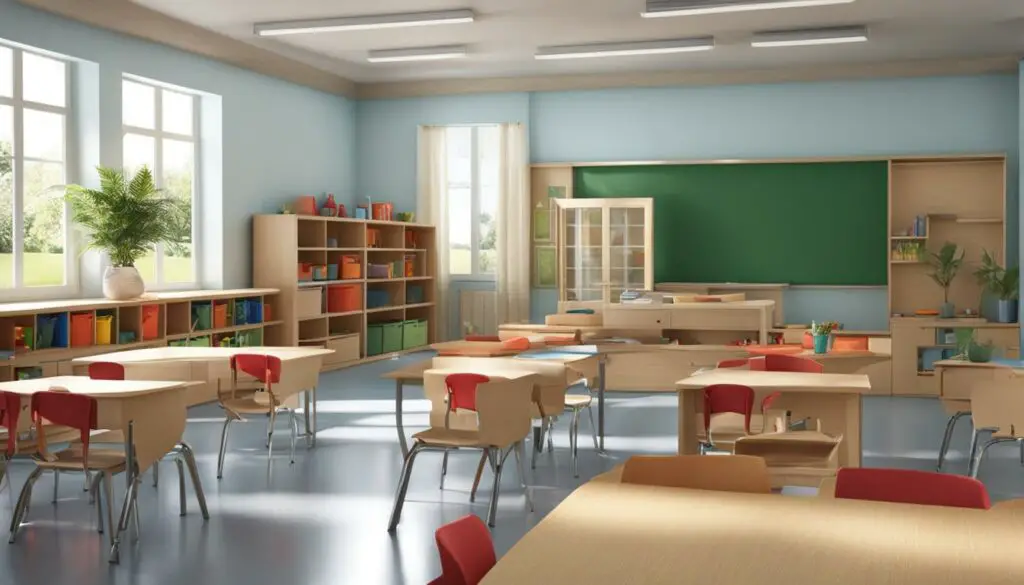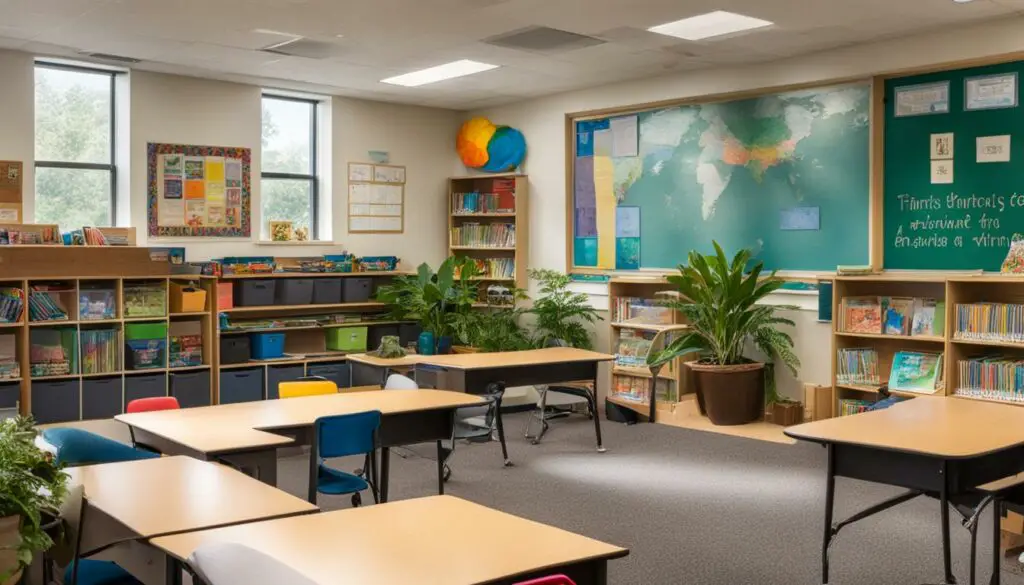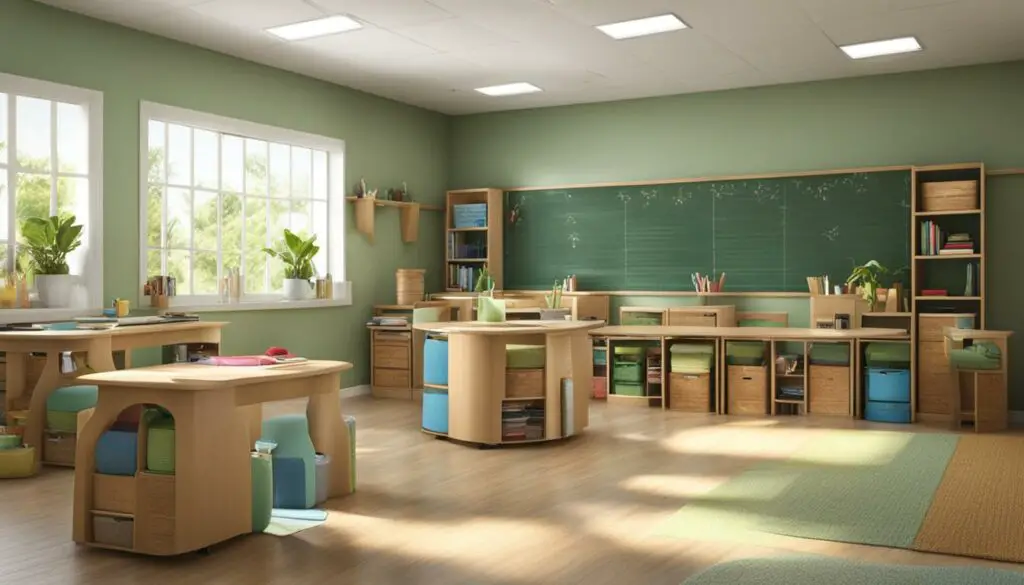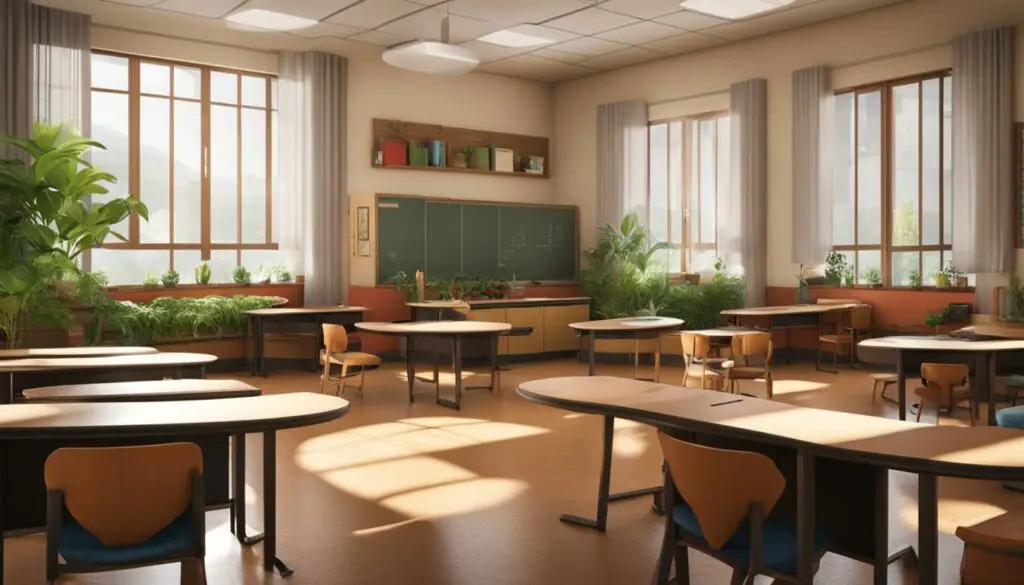Originally posted on October 28, 2023 @ 11:54 pm
If you’re looking for ways to create a calm, balanced, and harmonious learning environment, feng shui could be the answer. Feng shui is an ancient Chinese practice that involves arranging your environment in a way that maximizes the flow of positive energy, or chi. By applying feng shui principles to your classroom, you can help your students feel more comfortable, focused, and engaged, which can lead to better learning outcomes.
This guide will explore various tips and ideas to help you effectively feng shui your classroom. We’ll cover everything from understanding the principles of feng shui and choosing the right layout to incorporating natural elements and enhancing energy flow. By the end, you’ll have all the tools you need to create a feng shui classroom that supports optimal learning and growth.
Key Takeaways:
- Feng shui can help create a balanced and harmonious learning environment.
- Implementing feng shui principles can help students feel more comfortable, focused, and engaged.
- Choosing the right classroom layout, incorporating natural elements, and enhancing energy flow are essential to creating a feng shui classroom.
- Creating a dedicated space for homework and studying, promoting collaboration, and cultivating positive teacher-student relationships are also important in a feng shui classroom.
- By incorporating these tips and ideas, you can create a feng shui classroom that supports optimal learning and growth.
Understanding the Principles of Feng Shui in Classrooms
Feng shui is an ancient Chinese practice that involves arranging your environment to promote positive energy flow, or “chi”. When it comes to classrooms, implementing feng shui principles can help create a harmonious and balanced learning environment that can enhance student engagement and productivity.
The key principles of feng shui that can be applied in a classroom setting include:
- The Bagua map: This map is used to identify the different areas of your classroom and determine which elements should be incorporated in each area to promote balance and positive energy flow.
- Energy flow: It’s essential to ensure that energy can flow freely throughout your classroom by removing any obstacles or clutter.
- Decluttering: Decluttering your classroom can help create a calming and stress-free environment that promotes learning. By removing unnecessary items and keeping only what’s essential, you can allow for more space and keep the energy flowing smoothly.
- Balanced layout: It’s important to create a balanced layout that promotes harmony and equality for all students. This can be achieved through careful furniture placement and making sure there is adequate space for movement and interaction.
Implementing Feng Shui in a Classroom
To implement feng shui in your classroom, start by creating a floor plan that aligns with the principles listed above. Consider the placement of furniture and the flow of traffic, ensuring that students have enough space to move around without feeling cramped or overcrowded.
Additionally, declutter your classroom regularly to keep the energy flowing smoothly. Remove any unnecessary items and promote organization by providing ample storage space for necessary items such as books and supplies.
You can also incorporate natural elements such as plants, rocks, and crystals to enhance the positive energy flow in your classroom. These elements bring a sense of calmness and balance to the environment and can also help improve air quality.
Overall, by understanding and implementing feng shui principles in your classroom, you can create a space that promotes balance, harmony, and optimal learning.

Choosing the Right Classroom Layout for Feng Shui
When it comes to designing a feng shui classroom, the layout is a crucial aspect that can impact energy flow and student engagement. Here are some classroom layout options that you can consider:
Circular Arrangement
A circular arrangement is a popular feng shui layout that promotes equal participation and collaboration among students. This layout creates a sense of inclusivity and unity, allowing for improved communication and teamwork.

Desk Positioning
Desk positioning is another important consideration in feng shui classroom design. Avoid placing desks in direct alignment with the door or with their backs facing the door. Instead, position desks diagonally facing the door to promote a sense of security and attentiveness. You can also consider using adjustable desks to promote movement and flexibility.
Creating Designated Zones
Creating designated zones within your classroom can help promote a sense of order and balance. For example, you can create a quiet study area, reading corner, or an area for group work. This allows students to have a clear understanding of their designated space and fosters a sense of respect for others’ spaces.
Harmonizing with Colors: Feng Shui Color Palette for Classrooms
Choosing the right colors for your classroom is a key aspect of feng shui. Colors play a significant role in creating a balanced and harmonious learning environment. Here are some feng shui color ideas to help you create a calming and productive atmosphere in your classroom:
Green:
Green is a symbol of growth, balance, and harmony. It promotes calmness, relaxation, and a sense of well-being, making it an ideal color for a classroom. Green also represents nature and the environment, which can help create a connection between students and their surroundings. Consider adding green plants to your classroom or painting a feature wall in a shade of green.
Blue:
Blue is a calming color that promotes a sense of peace and relaxation. It is also associated with focus and concentration, making it a perfect color for a classroom. Blue can also improve communication and understanding, which can foster positive relationships among students. Consider incorporating blue elements such as curtains, rugs, or bulletin boards into your classroom.
Yellow:
Yellow is a cheerful color that promotes optimism and creativity. It can stimulate mental activity and enhance memory, making it a great color for a classroom. Yellow also represents the sun and warmth, which can create a welcoming and inviting atmosphere. Consider adding yellow accents such as pillows or artwork to your classroom space.
Orange:
Orange is a vibrant and energetic color that promotes enthusiasm and creativity. It can also stimulate mental activity and promote clear thinking, making it a useful color for a classroom. Orange also represents joy and celebration, which can enhance the learning experience. Consider incorporating orange elements such as cushions, lamps, or posters into your classroom design.

By incorporating these feng shui color ideas into your classroom design, you can create a harmonious and balanced environment that promotes optimal learning and growth. Remember to choose colors that resonate with you and your students, and experiment with different color combinations to find what works best for your classroom.
Decluttering and Organizing Your Classroom Space
Decluttering and organizing your classroom is essential to promote a harmonious and productive environment. A cluttered space can create a chaotic and overwhelming atmosphere, leading to distracted and stressed-out students.
Start by removing any unnecessary items from your classroom, such as old papers, broken supplies, and outdated materials. This will create more space and allow for better organization.
Use storage solutions, such as shelves, bins, and cabinets, to keep your classroom tidy and free of clutter. Assign a specific place for each item and label each storage container clearly.
When arranging furniture, make sure to leave enough space for movement and flow. Avoid positioning desks in a way that creates obstacles or blocks the natural flow of energy.
Pro Tip: Encourage your students to keep their own workspaces organized and decluttered. This will help them to stay focused and motivated.

“Less clutter leads to less stress and more peace of mind.” – Kelly Exeter
Bringing Nature Inside: Feng Shui Decorations for Classrooms
Natural elements and decorations play a significant role in feng shui and can create a visually appealing and calming atmosphere in your classroom. Incorporating natural elements such as plants, water features, and natural materials can enhance the energy flow and promote a peaceful learning environment. Here are some ideas for feng shui decorations:
- Plants: Adding plants to your classroom can help purify the air and promote relaxation. Choose plants that are low maintenance and fit the lighting and temperature conditions of your classroom.
- Water features: Water is known to represent wealth and abundance in feng shui. You can incorporate it into your classroom by adding a small tabletop fountain or an aquarium.
- Natural materials: Use natural materials such as wood, bamboo, and stone to bring the outdoors inside. You can add bamboo shades or wooden furniture to create a warm and inviting atmosphere.
- Artwork: Decorate your classroom with artwork that features natural scenery, such as landscapes or seascapes. You can also add images of animals or birds to promote a sense of calm and harmony.

“Nature is fuel for the soul.” – Anonymous
Enhancing Energy Flow with Lighting and Ventilation
Lighting and ventilation are essential factors that affect energy flow in a classroom. Implementing the right lighting and ventilation techniques can promote a calm and focused environment, ensuring that your students feel comfortable and energized throughout the day.
Maximizing Natural Light
Natural light is the most effective way to enhance energy flow in a classroom. It not only saves energy but also creates a positive atmosphere. Positioning desks and chairs near windows is an excellent way to maximize natural light in the classroom. You can also use sheer or light-colored curtains to diffuse the light and reduce glare.

Incorporating Artificial Lighting
When natural light isn’t sufficient, artificial lighting can be used to enhance energy flow. Overhead lighting can be too harsh, so opt for softer lighting fixtures such as floor lamps and table lamps. You can also use dimmer switches to adjust the lighting to suit the classroom’s needs throughout the day.
Ensuring Proper Air Circulation
Proper air circulation is essential for maintaining a healthy and comfortable classroom. It helps to reduce stuffiness and promote focus and productivity. Ensure that the classroom is well-ventilated by opening windows and doors when possible. If you are in a room without windows, consider using air purifiers and fans to circulate the air.
By incorporating these lighting and ventilation techniques, you can enhance the energy flow in your classroom and create a calm and focused environment for your students to learn and grow.
Creating a Balanced Homework and Study Area
Designing a designated space for students to do homework and study can significantly improve their focus and productivity. When creating this space, it’s essential to keep feng shui principles in mind to ensure a harmonious learning environment.
Firstly, it’s important to choose the right location for this space. Ideally, it should be in a quiet area of the classroom, away from distractions and noise. If possible, choose a location near a window to maximize natural light.
Next, consider the desk or table arrangement. Position the desk so that it faces the door or window and away from the wall, promoting a sense of openness and possibility. Avoid clutter on the desk, keeping only essential items such as pens, paper, and textbooks within reach.
Lighting is also crucial in creating a conducive study area. Natural light is best, so try to position the desk near a window or use a daylight-simulating lightbulb. Avoid fluorescent lights, which can cause eye strain and headaches.
Finally, incorporate calming and inspiring decorations in the study area. A plant or a motivational poster can provide a soothing and positive atmosphere while promoting a growth mindset.

Takeaway Tip:
Creating a balanced homework and study area involves choosing the right location, desk arrangement, lighting, and decor. Keeping these feng shui principles in mind can help students stay focused and productive.
Incorporating Feng Shui in Classroom Rules and Routines
Creating a positive and respectful learning environment involves not only the physical space but also the rules and routines established within the classroom. By incorporating feng shui principles into classroom rules and routines, you can further enhance the harmony and balance of the learning space.
Creating Calming Rituals
Introducing calming rituals at the beginning or end of each class can help create a sense of peace and tranquility for students. Consider starting each class with a brief mindfulness exercise or a few moments of deep breathing to help students release any tension or stress they may be holding onto from previous classes. Ending the class with a few minutes of quiet reflection or a positive class mantra can also help students leave the classroom feeling calm and centered.
Establishing Clear Boundaries
Clear boundaries are essential to creating a respectful and harmonious learning environment. Incorporate feng shui principles by creating clearly defined areas for different activities, such as a designated study area, a reading nook, and a space for group work. Communicate clear expectations for behavior and reinforce positive actions with praise and rewards.
Cultivating Positive Energy
The energy within a classroom can greatly impact student behavior and engagement. Encourage positive energy by incorporating feng shui principles such as natural light, plants, and calming colors. Consider creating a gratitude bulletin board where students can express appreciation for their classmates, teachers, and the learning environment.
By incorporating feng shui principles into classroom rules and routines, you can foster a positive and respectful learning space that supports student growth and development.

Stimulating the Senses: Sound and Aromatherapy in the Classroom
Creating a positive and harmonious environment in the classroom goes beyond just the physical elements. Incorporating sound and aromatherapy can also have a significant impact on the energy flow and atmosphere of your learning space. Here are some feng shui tips for classrooms to help stimulate the senses:
Sound
The right kind of sound can have a calming effect on the mind and aid in concentration. To enhance the auditory environment of your classroom, try:
- Playing soft, instrumental music in the background to create a relaxing atmosphere.
- Using white noise or nature sounds to block out distracting noises and promote focus.
- Incorporating chimes or bells to signal transitions between activities, creating a peaceful and structured atmosphere.

Aromatherapy
Using essential oils or natural scents can stimulate the olfactory senses and create a calming and productive atmosphere. Here are some ways to incorporate aromatherapy into your classroom:
- Diffusing essential oils such as lavender, peppermint, or lemon to promote relaxation, clarity, or energy.
- Using natural scents such as fresh flowers or herbs to create a pleasant atmosphere and connect with nature.
- Encouraging students to bring in their own scent preferences to create a personal and comfortable space.
By incorporating sound and aromatherapy into your classroom, you can help create a well-rounded feng shui environment that promotes optimal learning and growth for your students.
Enhancing Collaboration and Communication
Collaboration and communication are essential for creating a positive and productive learning environment. By incorporating feng shui principles into the layout and design of your classroom, you can encourage students to work together and communicate effectively. Here are some classroom feng shui ideas to enhance collaboration and communication:
Creating Group Workspaces
Arrange desks in a circular or round shape to encourage open communication and collaboration. If space is tight, consider placing desks in pairs and rotating them periodically, so students have a chance to work with different classmates.
Seating Options
Offer multiple seating options to cater to different learning styles and preferences. Include comfortable chairs, bean bags, and floor cushions to create a relaxed and inviting atmosphere.
Interactive Displays
Create interactive displays that encourage students to work together and share ideas. Use a whiteboard or chalkboard to write prompts or questions and have students work in groups to answer them. Hang a large world map or timeline and have students work together to add information and insights.
Collaborative Projects
Assign collaborative projects that require students to work together and communicate effectively. Encourage them to share their ideas, listen to each other, and find common ground. Celebrate the successes and achievements of the group as a whole, not just individual students.

By incorporating these feng shui tips for classrooms, you can create a collaborative and communicative learning environment that fosters growth, creativity, and engagement among students. Remember to keep the focus on the collective success of the group, and you will see a positive impact on classroom culture and student achievement.
Mindful Technology Use in a Feng Shui Classroom
Technology has become an integral part of education, and it is crucial to incorporate it in a balanced way that aligns with feng shui principles. Here are some feng shui tips for classrooms on mindful technology use:
- Minimize distractions: Encourage students to turn off notifications on their devices during class time to minimize distractions and improve focus.
- Proper placement: Keep computers and other electronic devices away from the main entrance, as they can disrupt energy flow. Place them on a desk with a solid back, and avoid having them face directly towards a door.
- Avoid clutter: Keep cords and wires well-organized and out of sight as they can create visual clutter and disrupt the flow of energy in the classroom.
- Limit screen time: Encourage students to take breaks from their devices and engage in physical activity or mindful reflection. Incorporate feng shui decor and natural elements like plants to counterbalance the effects of screen time.
- Mindful use: Teach students to use technology mindfully and with intention, emphasizing the importance of balance and harmony in all aspects of their lives.

By incorporating these feng shui tips for classrooms, you can create a balanced and mindful approach to technology use that supports optimal learning and growth.
Incorporating Feng Shui in Classroom Rules and Routines
Creating a positive and respectful learning environment goes beyond just the physical layout of your classroom. By integrating feng shui principles into your classroom rules and routines, you can cultivate a mindful and harmonious atmosphere that promotes optimal learning and growth.
Establish Clear Boundaries
Clear boundaries are essential to creating a harmonious classroom. By establishing clear rules and expectations, both you and your students will know what is expected of them, and there will be fewer distractions and disruptions to the learning process.
Consider implementing calming rituals at the beginning and end of each class, such as a moment of silence or deep breathing exercise. This can help to create a calm and focused atmosphere, and give students a chance to transition between classes.
Create Calming Rituals
Creating calming rituals is an effective way to promote a peaceful classroom environment. One of the primary principles of feng shui is finding balance and harmony with one’s surroundings, and you can apply this principle to your classroom rituals.
Think about incorporating natural elements, such as plants or an aquarium, into your classroom space. This can help to create a calming effect, as well as promoting an appreciation for the natural world.
Encourage Respectful Communication
Effective communication is the foundation of a successful classroom. Encouraging respectful communication among your students helps to foster a supportive and positive learning environment. Use positive language and encourage your students to express themselves openly and respectfully.
You may also want to consider implementing a “no put-downs” policy in your classroom. This means that students are not allowed to use insulting or demeaning language towards one another, creating a more positive and respectful learning environment.
Embrace Flexibility
Finally, it’s important to remember that every classroom is unique, and what works for one may not work for another. Embracing flexibility and being open to new ideas can help to create a more harmonious and productive learning environment.
By incorporating feng shui principles into your classroom rules and routines, you can create a balanced and respectful learning environment that promotes growth and success.

Incorporating Feng Shui in Classroom Rules and Routines
Creating a positive and respectful learning environment is essential in any classroom. By incorporating feng shui principles in your rules and routines, you can enhance the overall energy and atmosphere of the classroom.
Establishing Clear Boundaries
Setting clear boundaries can help create a sense of order and respect in the classroom. One way to do this is by establishing a designated space for each student’s belongings, such as a cubby or locker. This allows for a clutter-free classroom and promotes a sense of personal responsibility and ownership.
Creating Calming Rituals
Creating calming rituals, such as starting each day with a brief meditation or taking a few deep breaths before beginning a task, can help students feel more centered and focused. This can also help to reduce anxiety and stress levels in the classroom, promoting a more relaxed and productive learning environment.
Encouraging Respectful Communication
Encouraging respectful communication among students and between students and teachers can foster a sense of community and support. Feng shui principles suggest avoiding negative language and promoting positive affirmations. Encourage students to speak kindly and respectfully to one another, and model this behavior as a teacher.
Keeping a Tidy Classroom
Decluttering and tidying up the classroom on a regular basis can promote a sense of calm and order. Encourage students to keep their individual spaces clean and organized, and establish a rotating schedule for classroom cleaning tasks.
Creating a Positive Atmosphere
Creating a positive and uplifting atmosphere in the classroom can promote a sense of well-being and engagement among students. Use positive affirmations and decorations to promote a sense of joy and positivity in the classroom. Avoid negative language and create a culture of respect, cooperation, and support.

“Incorporating feng shui principles in classroom rules and routines can create a harmonious and supportive learning environment.”
Conclusion
By now, you have learned how to effectively apply feng shui principles to your classroom. Using the tips and ideas discussed in this guide, you can create an environment that promotes positive energy flow, supports learning and productivity, and cultivates a sense of calm and harmony.
Remember to approach the feng shui process mindfully, taking into consideration the unique needs and characteristics of your classroom and its occupants. Be patient and willing to make adjustments as needed, and always keep in mind the ultimate goal of creating a balanced and harmonious learning space.
Implementing feng shui ideas may take some effort and time, but the positive impact on your classroom’s energy and atmosphere can be significant. We hope this guide has provided valuable insights and practical techniques to help you create a feng shui classroom that supports growth, learning, and well-being.
FAQ
What is feng shui?
Feng shui is an ancient Chinese practice that focuses on arranging a space to create balance and harmony, allowing for the flow of positive energy.
How can feng shui benefit a classroom?
Implementing feng shui principles in a classroom can create a more conducive learning environment, enhancing focus, productivity, and overall well-being for both students and teachers.
What are some basic feng shui principles for classrooms?
Some basic feng shui principles for classrooms include ensuring good energy flow, decluttering the space, and creating a balanced layout.
How can I improve energy flow in my classroom?
To improve energy flow, make sure there is enough space to move around freely, avoid blocking doorways or windows, and incorporate circular arrangements or curved lines.
What are some tips for decluttering and organizing a classroom?
Start by removing unnecessary items and creating designated storage areas. Use bins or shelves to keep supplies organized and create a clutter-free space that promotes focus and productivity.
What colors are recommended for a feng shui classroom?
Colors like blue, green, and yellow are often recommended for a feng shui classroom as they promote a sense of calmness, creativity, and focus.
How can I incorporate nature into my classroom?
You can incorporate nature into your classroom by adding plants, using natural materials such as wood or bamboo, and displaying artwork or images of nature.
What should I consider when choosing lighting for a feng shui classroom?
Consider maximizing natural light, using full-spectrum lighting, and ensuring proper lighting levels to create a bright and energizing environment.
How can I create a balanced homework and study area?
Create a dedicated space for homework and studying with a comfortable chair, a clutter-free desk, good lighting, and minimal distractions.
How can I integrate feng shui in my classroom rules and routines?
Integrate feng shui in your classroom rules and routines by creating calming rituals, establishing clear boundaries, and promoting a respectful and positive learning environment.
Can sound and aromatherapy be used in a feng shui classroom?
Yes, sound and aromatherapy can be used to create a soothing and conducive environment. Soft background music, nature sounds, and calming scents can enhance the overall atmosphere.
How can feng shui encourage collaboration and communication in a classroom?
Arrange group workspaces, provide flexible seating options, and incorporate interactive displays to foster collaboration and effective communication among students.
How can technology be incorporated mindfully in a feng shui classroom?
Place technology devices strategically, minimize distractions, and create guidelines for mindful and balanced technology use to maintain a harmonious learning environment.
How can a feng shui classroom nurture positive teacher-student relationships?
Nurturing positive teacher-student relationships in a feng shui classroom involves creating a supportive and respectful atmosphere, listening actively, and offering guidance and encouragement.
What are some mindfulness practices for a feng shui classroom?
Incorporate mindfulness practices such as deep breathing exercises, guided meditations, and moments of reflection to promote focus, relaxation, and emotional well-being in a feng shui classroom.
